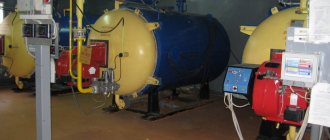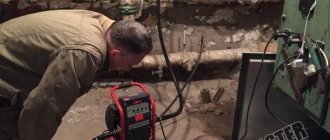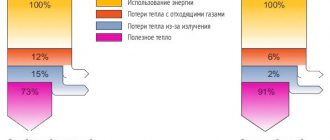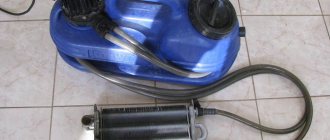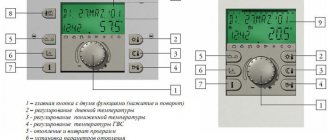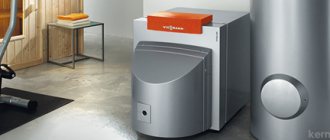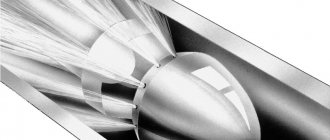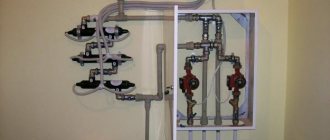Why combustion products accumulate
The raw materials for the heating boiler can be firewood, coal, peat or pellets. When any fuel burns, it leaves behind various deposits that negatively affect the operation of the device. Resin in a solid fuel boiler accumulates much faster in the following cases:
- use of low-quality or wet fuel;
- too much fuel material placed in the combustion chamber;
- use of a heating device for the disposal of household waste;
- the operating temperature is not high enough, which causes the fuel to smolder rather than burn;
- the use of firewood, which releases large quantities of volatile resinous substances, which, when the temperature drops, settle on the walls of the boiler.
Read more about problems with boiler temperature on our Zen channel.
Oxygen deficiency and errors made during the assembly of the heating device, in particular, insufficiently high chimney height, can also increase the amount of unwanted deposits.
Flushing the boiler from scale: consequences of ignoring
Modern mains use ordinary hard water, which quickly leads to the inside of the equipment being covered with scale. Boilers must be cleaned on a regular basis. If cleaning is not done on time. The consequences can be the most unpredictable, but definitely unpleasant.
The design of the gas boiler is such that the coolant coming from the return line cools the cavities of the heating elements located inside. The coolant cannot effectively cool the elements if they are covered with a thick layer of scale. If the boiler constantly overheats, it will soon stop working altogether.
What will happen if you ignore flushing?
- Scale consists of mineral deposits that do not promote thermal conductivity. Scale causes the water to heat up slowly, which requires significantly more electricity. A thick layer of scale leads to increased gas consumption, which increases the price of using the boiler.
- Scale can lead to boiler failure due to difficult coolant passage. This increases the load on the circulation pump, which leads to its rapid breakdown.
Before flushing the boiler, it is important to pay attention to what kind of liquid flows through the line. The need for frequent flushing will be due to very hard and contaminated water. In order to reduce the frequency of cleaning, it is necessary to use antifreeze - it is important that it is not expired
In order to reduce the frequency of cleaning, it is necessary to use antifreeze - it is important that it is not expired
Why is resin in a boiler dangerous?
Cleaning a solid fuel boiler from tar and other contaminants should be carried out regularly, and not occasionally. Otherwise, negative consequences will not be long in coming. For starters, heat transfer rates will decrease—it will take much more time to properly warm the house, and the heat will be distributed unevenly. A deposit of just a few millimeters in height reduces the boiler power by 30%, which entails an increase in raw material consumption and financial costs for heating.
A solid fuel boiler, inside of which a thick layer of soot, tar and tar has formed, will not last long. First of all, its main elements, which are assigned heating functions, will fail. In addition, oily deposits that accumulate in large quantities have corrosive properties, which also shortens the life of the heating device. The risk of smoke in the boiler room also increases due to a decrease or complete absence of draft in a polluted combustion chamber.
Why flush your heating system?
Over time, deposits form on the internal surfaces of the heating system. In the heat exchanger they lead to overheating of the boiler, in the pipes they lead to a slowdown in the circulation of the coolant. Timely flushing allows you to remove deposits and avoid accidents in the future.
The main reasons for the appearance of deposits:
- Water with a high content of hardness salts;
- Using antifreeze, mixing different antifreezes;
- Frequent replenishment of coolant due to leaks;
- Lack of maintenance to spot problems early.
If it is possible to refuse antifreeze, it is better to do so. You can also think about organizing a water treatment system.
The heat exchanger burst. Why does a cast iron boiler collapse?
Possible signs:
- The boiler, heated floors, radiators do not heat up or heat up worse;
- Interruptions in the operation of the circulation pump;
- Increased fuel consumption;
- Frequent boiler shutdowns.
At the first signs, you need to contact a specialist. If the problem is deposits, flushing will be required.
Boiler cleaning methods
On the Internet you can find many articles and videos on how to clean tar from a solid fuel boiler. The most important thing about this procedure is its regularity. Even removing contaminants with all care, down to the last particle, but doing this at intervals of six months, it is unlikely that it will be possible to improve the performance of the heating device. There are 3 main ways to clean combustion products from the internal walls of the boiler, each of which must be familiarized in detail before starting the procedure.
Mechanical
Involves the use of special tools: pokers, metal brushes and brushes, scrapers and blades of various sizes. The main stages of work are as follows:
- Melt the boiler so that, under the influence of high temperature, the hardened resin softens and moves away from the walls more easily.
- Turn off the device completely, wait until it cools down a little and be sure to leave the damper open.
- Using the entire set of tools, carefully remove dirt from the internal surface of the combustion chamber.
- Once cleaning is complete, light the kettle again, allowing the remaining resin particles to burn out completely.
If firewood from resinous tree species was used as a fuel material, and a thick layer of hardened soot has accumulated on the walls of the device, you need to prepare in advance for the cleaning procedure. To do this, you will need ½ bucket of anthracite or about 15 kg of dry, non-resinous firewood, which can burn out most of the greasy deposits and significantly facilitate further mechanical cleaning.
When working, use metal tools with extreme caution to avoid damaging the walls of the device with sharp edges.
Chemical
It is based on the use of special products for cleaning solid fuel boilers from tar, soot and tar. The chemical method of removing contaminants from the surfaces of heating equipment is very popular, as it does not require significant time and physical effort.
There are two methods of chemical cleaning:
- Contaminated boiler walls are treated with an acid-based cleaning composition, which quickly destroys deposits, and then getting rid of them mechanically is not difficult.
- The chemical composition is poured directly onto the burning fuel. In this case, the crystals of the special agent react with the resin and soot, destroy them and are removed from the boiler through the chimney.
To treat the combustion chamber from the inside with a chemical for cleaning a solid fuel boiler, the composition must be heated to a certain temperature and, using a pump, fed into the system. The most common reagents are:
- Adipic acid.
It is mixed with water to obtain a solution of a certain concentration, which is slowly poured into the boiler using a pump. By interacting with combustion products, the acid dissolves them and converts them into salts. As soon as they precipitate, the remaining contaminants are washed off with clean water. - Sulfamic acid.
Also intended for preparing a solution that enters the boiler under pressure. The layer of deposits formed on its inner walls is destroyed under the influence of the reagent and can be easily removed using running water.
The choice and concentration of the cleaning agent depends on the nature and degree of contamination. After treatment with chemicals, the inner surface of the combustion chamber must be thoroughly dried and ventilated before starting the device.
When using chemicals to remove tar deposits, it is important to follow safety rules:
- work with reagents only with rubber gloves and a mask;
- do not increase the concentration of the solution at your own discretion;
- do not use expired chemicals;
- limit access of children and pets to reagents.
Another method of cleaning resin is based on the use of a special solution for treating contaminated boiler surfaces - soft blasting. It requires a special device that allows you to evenly apply the reagent to the walls of the combustion chamber, and the cleaning composition itself contains chalk and baking soda. Experts recommend chemical cleaning of heating equipment only in cases where a lot of deposits have accumulated and it is not possible to deal with them using gentle methods. This is due to the fact that any reagents affect not only dirt, but also metal surfaces, so their frequent use can have undesirable consequences.
Steam
This cleaning method requires a steam generator used to treat the solid fuel boiler from the inside. The essence of the method is simple: steam is supplied to the walls of the combustion chamber under high pressure, which softens deposits and makes them easier to remove. Steam cleaning makes it possible to gently get rid of not only a layer of dirt, but also fungus and mold, which often attack the internal surfaces of heating equipment.
How often there is a need to clean the internal walls of a solid fuel boiler is determined primarily by the type of raw material used. If high-quality dry firewood or coal is placed in the firebox, it is recommended to remove the resin layer no more than once a month or 40 days. When the fuel is wet or has low performance, the procedure will have to be carried out more often - every 15-20 days. At the same time, it is necessary to monitor the functioning of the device - if the rhythm of work is disrupted, it is better to carry out unscheduled cleaning. You need to inspect the internal walls of the boiler and chimney weekly in order to detect the accumulation of tar and soot in time and take action.
Read more about cleaning heating boilers on our Zen channel.
Mechanical cleaning of the boiler
Maintenance of boiler and heat exchange equipment includes mechanical cleaning of heating surfaces or heat transfer surfaces.
There are cleanings of both internal surfaces (water and steam) and external combustion spaces.
General view of the boiler
Cleaning the boiler combustion chamber
The state of the combustion space before cleaning after 1 year of operation on gas. It is possible that your equipment is now in exactly this condition. Next to it is the state of the combustion chamber after cleaning.
View before and after washing
There are certain proven figures for saving resources, namely: 1 mm of soot or deposits on heat transfer surfaces reduces the efficiency of the unit by 5-7% - in other words, if with a clean boiler you paid 100 rubles a month for gas, then with a dirty one (relatively speaking) you will pay 107 rubles, and if it is very dirty, 121 rubles. After final contamination, the boiler will simply break due to metal deformation or thermal expansion. And if we add the effect of deposits inside the boiler (water or steam side), then we multiply by two. This is why it is very important to carry out timely maintenance of equipment and units involved in the operation of your engineering complex.
Description of the process of cleaning the boiler combustion chamber
Flushing the boiler on the gas or diesel side. Each cleaning or maintenance operation of the boiler is carried out after turning off the fuel and electrical power.
Cleaning heating surfaces should be done:
- once every three months when operating on diesel fuel,
- once a year when operating on natural gas.
When using approved other types of fuel, the cleaning frequency is determined based on the results of inspections of heat exchange surfaces and measurements of flue gas temperatures. The frequency of cleaning also depends on the correct setting of the combustion mode.
If the final flue gas temperature increases by 30 °C compared to the temperature with a clean boiler at a given load, it is necessary to clean:
- open the front, remove intensifiers;
- perform mechanical cleaning of the flame pipe with scrapers and brushes, and of the smoke pipes with brushes. From the second pass pipes, soot is removed into the flue gas collector. Soot must be removed from the firebox and flue gas collector using a vacuum cleaner or manually after each cleaning;
- install intensifiers, replace damaged ones;
- Clean the surface of the refractory layer of the front door of the boiler with a soft non-metallic brush. Make sure there is no damage to the thermal insulation (lining). If necessary, repair the thermal insulation.
Approximately the same operations are performed when cleaning small wall-mounted boilers and large steam boilers with many tube (convective) bundles inside the firebox.
Photos of works
Boiler after cleaning
We also suggest that you look at the dirty plate of the plate heat exchanger. Where the red color is deposits due to water with iron impurities, the shiny color is the metal of the plate that does not interact with the coolant (water).
Prevention
To extend the life of the heating device and facilitate the procedure for cleaning resin, experts recommend following several mandatory rules:
- provide access to the oxygen combustion chamber in the required volume;
- do not load freshly cut firewood into the firebox or with a humidity level exceeding 20%;
- refuse fuel material made from resinous tree species (pine, spruce, birch, etc.)
Also, for the purpose of prevention, you can turn to folk remedies that slow down the process of accumulation of deposits on the walls of heating equipment.
Option 1: use table salt, which must be poured directly into the firebox to break down contaminants and remove them through the chimney. Option 2: sprinkle potato starch or thoroughly dried potato peelings onto burning wood or coal. Under the influence of high temperature, they begin to actively release substances that soften deposits accumulated on the walls of the combustion chamber. When the fuel burns out and the boiler temperature drops, all that remains is to clean off the top layer of dirt with a metal spatula or scraper.
These methods cannot replace complete cleaning, but in between main procedures they can reduce the rate of deposit formation.
Chemical flushing of a gas boiler
When chemically flushing a boiler, plaque and scale are removed from contaminated surfaces of boiler equipment and heat exchanger fragments, thanks to treatment with various chemical compounds and reagents. Most often, acid is used for washing boilers, which effectively removes carbonate scale, which is formed when magnesium and calcium salts and ferric iron combine and settle on the surface of the heat exchanger. Chemical washing is a standard, simple procedure that you can do yourself at some intervals. This flushing usually does not require disassembly of the structure.
Chemical cleaning of a gas boiler.
To carry out chemical flushing, you will need a chemical reagent and special equipment called a booster for flushing the heat exchanger. A booster is a device that consists of a tank for a cleaning agent, a pump and a heating element. During the procedure for flushing a gas boiler using a booster, a warm solution is first prepared and introduced into the heat exchange system (for acid flushing).
Thanks to the device, the cleaning reagent circulates and the waste liquid is removed. The acid chemical wash booster can be used on any type of gas boiler and is capable of effectively cleaning any type of boiler equipment. The main difference between a booster and installations that clean steam systems is that the booster does not need to use a heating element, since the cleaning liquid can be heated by the heat exchanger itself.
However, this is unsafe and not as effective, so it is recommended to use boosters that have heating elements, which allows you to use a solution of the same temperature and act on different parts of the heat exchanger with the same efficiency.
Gas boiler system diagram.
Acid washing is used to remove carbonate scale or ferric scale. The main reagents that are included in these solutions are sulfuric or hydrochloric acids; phosphoric or nitric acids are less commonly used. The reagent is selected depending on the type of contamination and the abundance of scale; the materials from which the heat exchanger and boiler are made are also taken into account.
Do-it-yourself flushing of a double-circuit gas boiler is carried out in two stages. At the first stage, an active reagent that has acidic properties is used. Using a reversible pump, it is necessary to create a powerful flow of solution, eroding the layer of deposits that would be affected by the acid.
The procedure takes from 2.5 to 6 hours, depending on how dirty the surfaces of the gas boiler are. When deposits and scale have dissolved, it is necessary to remove the active solution and fill the heat exchanger with a solution that neutralizes the acid residue. If the heat exchanger is made of cast iron, then due to the likelihood of the opposite effect, it is better not to flush the boiler with your own hands.
Cleaning device elements
In order to clean a gas boiler, preliminary preparation is needed. This device consists of several elements:
- igniter;
- nozzles and burner;
- gas filter;
- heat exchanger;
- firebox;
- the chimney itself.
Each element of a gas boiler has its own cleaning characteristics. Let's consider separately:
- Igniter: first you need to shut off the gas supply to the boiler, unscrew the element, thoroughly clean it with a brush, blow it out, and install it in place.
- Nozzles and burner. The algorithm is practically the same: you need to turn off the gas, remove the burner, carefully unscrew the nozzle, then clean the elements with a brush, blow out the burner with a vacuum cleaner, insert it and the nozzle into place;
- Heat exchanger. The difficulty is that it can become clogged both inside and outside (with soot). Cleaning the outside is done in the same way: with brushes and pipe cleaners. The inside of the heat exchanger is cleaned with chemicals.
In order not to search on the Internet for ways to clean soot from a boiler, or to call a specialist, it is necessary to carry out preventive procedures.
